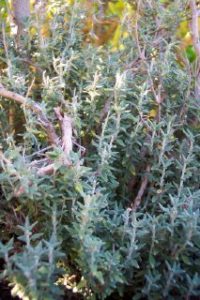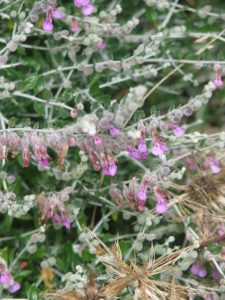
Cat thyme (Teucrium marum) is not a thyme although it resembles one. It is instead related to germander, a small woody shrub that is often used as an edging in knot gardens. Cat thyme also makes a nice edging in a knot garden.
Cat thyme is attractive to cats. Some cats even prefer it over catnip. Gardeners often have to build wire cages around their cat thyme to prevent the neighborhood cats from rolling in it, destroying the plants. Cat thyme uses a different chemical than catnip to attract felines. Catnip smells musky like a skunk. Cate thyme has more of minty camphor odor.
Cat thyme has been used medicinally for centuries. It was most often used to treat gallbladder or stomach disorders. When dried, the leaves cause sneezing so they were used as snuff and to treat “disorders of the mind”.
Cat thyme is native to the western Mediterranean so it is drought tolerant. It does best in a sunny spot growing in well-drained soil.

Cat Thyme Flowers
It is often listed as hardy through zone 5, but north of zone 7, it requires protection to make it through the cold winters. Full grown plants can grow up to 3 feet tall but rarely reaches that height in colder areas where it is more usually grows to only 12 inches tall. The leaves are small, oval, and gray in color. The tops of the foliage is covered with fine hairs.
The flowers are pink and grow on three to five inch spikes. Bloom time is July through September. Oddly, the plants usually only flower on one side of the spikes. The flower spikes should be trimmed off when the flowers are finished to keep the plants looking their best. Bees find the flowers irresistable.
Cat thyme does not produce seed. Propagation is through cuttings.
